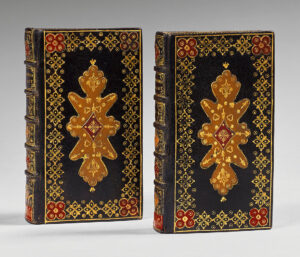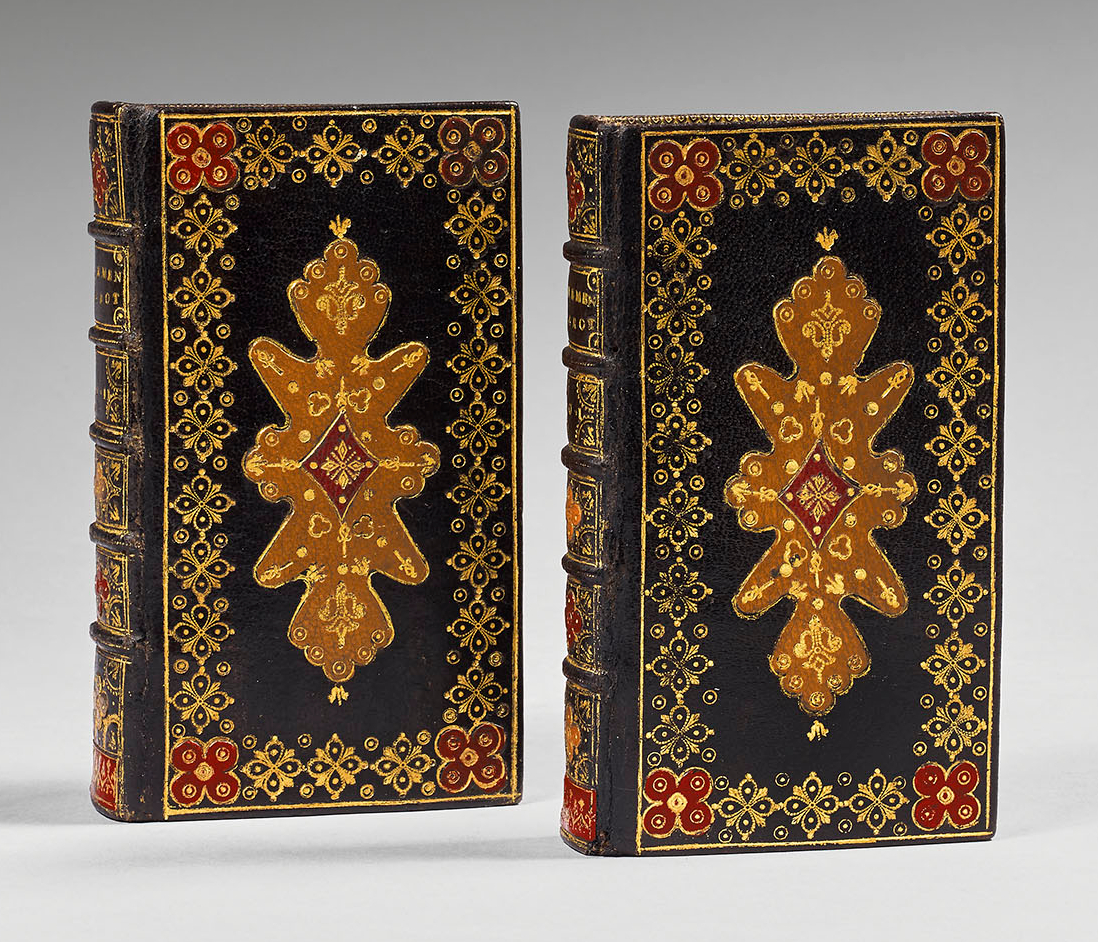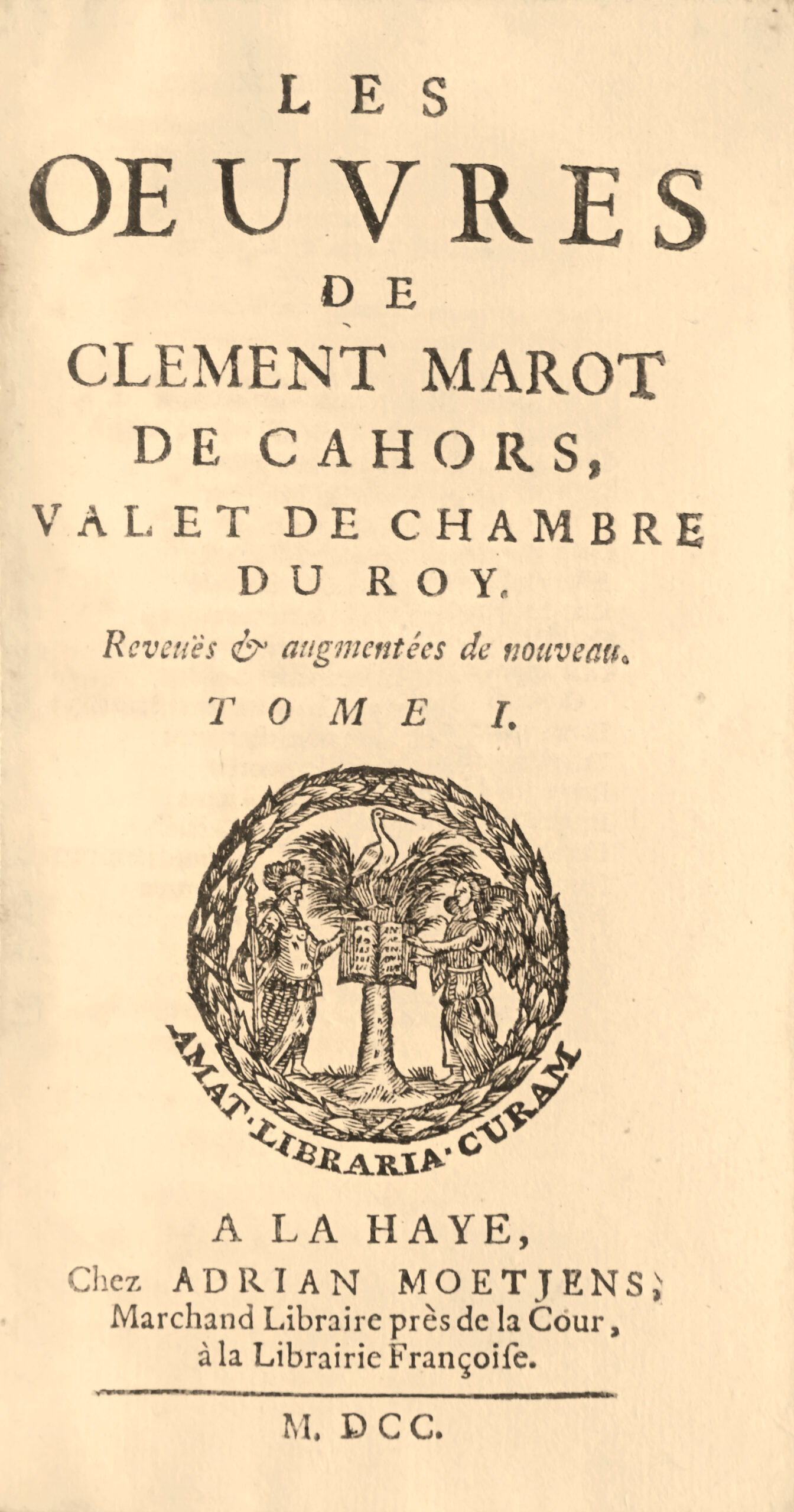A la Haye, chez Adrian Moetjens, Marchand Libraire près de la Cour, à la Librairie Françoise, 1700.
Two small volumes 12mo of xvi pp., 732 pp. and (8) ll. of table.
Midnight blue morocco, in the corners, four-lobed mosaic of red morocco decorated, central piece of beige morocco and red lozenge, decorated with small tools, wide border of gilt fleurons, gilt fillet in frame, spines ribbed decorated with tools and four-lobed mosaic red and brown, gilt over marbled edges. Contemporary mosaic binding.
133 x 74 mm.
The most valuable and bibliophilic seventeenth-century edition of the works of Clement Marot.
“Beautiful edition, the most sought after… It is difficult to obtain copies with well preserved margins and whose leaves do not have a reddish tint” mentions Brunet (Manuel du Libraire et de l’amateur de livres, III, c. 1418). Case of the present copy, very pure and with very wide margins (height: 133 mm).
In his elegies, epistles, ballads, rondeaux, chansons, laments, epigrams and psalms, Marot brings indeed the best of the old French poetry and a really popular inspiration under the varnish of the court politeness.
Official poet adulated by François I and Charles V, Marot marks by his talent the first truly remarkable period of French poetry whose spirit will reappear in La Fontaine who did not fail to pay tribute to “Master Clement“.
De sa grand amye
Dedans Paris, ville jolie,
Ung jour passant melancolie,
Je prins alliance nouvelle
A la plus gaye damoyselle
Qui soit d’icy en Italie.
D’honnesteté elle est saisie,
Et croy, selon ma fantaisie,
Qu’il n’en est gueres de plus belle
Dedans Paris.
Je ne vous la nommeray mye,
Sinon que c’est ma grand amye ;
Car l’alliance se feit telle
Par un doulx baiser que j’eus d’elle,
Sans penser aulcune infamie.
Edition which joins the Elsevier collection. The two title fleurons are similar in the good edition, while they are different in the reprint which was made under the same date. (They are similar here).
This edition has always been prized by great bibliophiles and bibliographers list the names of its illustrious owners: “Baron Pichon, Comte d’Hoym, Lignerolles, De Backer, La Roche Lacarelle, Didot, Mac Carthy, Pixérécourt, Labedoyere, Solar… As for Deschamps (Supplément to Brunet, he mentions the very high bids reached in the 1870’s by beautiful copies with margins of at least 129 mm: (the present copy measures 133 mm) “in mor. With mor. coublures by Boyet, Gaignat copy, 760 fr. Brunet (137 mm high); in mor. by Padeloup, with the arms of the count of Hoym, 1 500 fr. Baron Pichon, and would be sold for more today; in Bradel morocco, but only 129 mm high, 250 fr. Bordes; in Trautz morocco, a wide-margined copy, announced on strong paper, 705 fr. Benzon; in Padeloup morocco, height 129 mm, 330 fr. Leb. De Montgermont; in mor. by Bauzonnet, but spotted with freckles, 120 fr. Labitte (1870); in Bauzonnet mor., 200 fr. in catal. Morgand et Fatout, and in mor. By binders di secondo cartello, two copies at 180 fr. in the same cat.; in mor. by Trautz, 400 fr. cat. Fontaine of 1872. We will also mention a charming copy, bound in mor. with mor. doublures, by Padeloup, height 134 mm which is part of the cabinet of Mr. de Ganay.”
Let us recall that a book of bibliophily was negotiated at that time from 10 gold francs.
The present copy, bound in a contemporary mosaic binding, is among the most precious known.
“During the 18th century and especially from 1715 to 1775, a small number of bookbinders, mostly Parisian, executed for some amateurs bindings of a very particular character, decorated in mosaic of application of leathers of different colors.
The technique used was known since the sixteenth century and will remain in use. It is very accurately described by Dudin under the name of “binding with compartments” in his Art du relieur doreur de livres published in 1772, with the patronage of the Royal Academy of Sciences: “One begins by covering his book in white calf or colored morocco or in such other background as one wants; it is only necessary that the leather is the best chosen and the most free of all defects, holes and stains that one can get. When the leather is quite dry, one puts on it a drawing such as one wants to carry out whose various parts are coloured; one tracing the drawing on the calf and on this tracing one sticks pieces of morocco dyed in various colors and of all the colors; one pare these skins the thinnest that it is possible, so that one can see the day through; They are cut into pieces of the size of the parts of the drawing that they must represent and they are glued with flour glue on the skin, putting very little glue so as not to make any thickness; when these pieces are glued, the book is put in press for a certain time so that they unite and do not make more, so to speak, than one body with the skin which makes the bottom. .. Then we gild all that is covered with drawing, as well as all the bottom which is sown with small points… One seeks over this gold the outline of the flowers, foliage and other parts of the drawing, following exactly these contours to circumscribe them of a net of gold which finishes the end of it.”
The “compartments” bindings were extremely meticulous in their technique and very expensive to produce, which explains why the examples that have come down to us are very rare.
Precious bindings from the “Atelier des Petits Classiques” so named because the common character of these rare mosaic bindings is to cover small classic editions.



